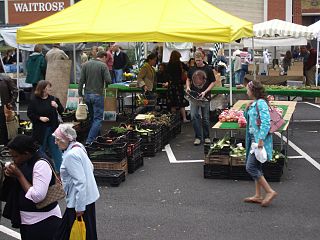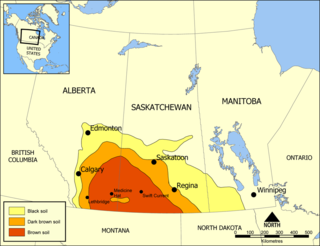Related Research Articles

A farmer is a person engaged in agriculture, raising living organisms for food or raw materials. The term usually applies to people who do some combination of raising field crops, orchards, vineyards, poultry, or other livestock. A farmer might own the farm land or might work as a laborer on land owned by others. In most developed economies, a "farmer" is usually a farm owner (landowner), while employees of the farm are known as farm workers. However, in other older definitions a farmer was a person who promotes or improves the growth of plants, land or crops or raises animals by labor and attention.

Intensive agriculture, also known as intensive farming, conventional, or industrial agriculture, is a type of agriculture, both of crop plants and of animals, with higher levels of input and output per unit of agricultural land area. It is characterized by a low fallow ratio, higher use of inputs such as capital and labour, and higher crop yields per unit land area.

Sustainable agriculture is farming in sustainable ways meeting society's present food and textile needs, without compromising the ability for current or future generations to meet their needs. It can be based on an understanding of ecosystem services. There are many methods to increase the sustainability of agriculture. When developing agriculture within sustainable food systems, it is important to develop flexible business process and farming practices. Agriculture has an enormous environmental footprint, playing a significant role in causing climate change, water scarcity, water pollution, land degradation, deforestation and other processes; it is simultaneously causing environmental changes and being impacted by these changes. Sustainable agriculture consists of environment friendly methods of farming that allow the production of crops or livestock without damage to human or natural systems. It involves preventing adverse effects to soil, water, biodiversity, surrounding or downstream resources—as well as to those working or living on the farm or in neighboring areas. Elements of sustainable agriculture can include permaculture, agroforestry, mixed farming, multiple cropping, and crop rotation.

Local food is food that is produced within a short distance of where it is consumed, often accompanied by a social structure and supply chain different from the large-scale supermarket system.

The following outline is provided as an overview of and topical guide to organic gardening and farming:

Community-supported agriculture or cropsharing is a system that connects producers and consumers within the food system closer by allowing the consumer to subscribe to the harvest of a certain farm or group of farms. It is an alternative socioeconomic model of agriculture and food distribution that allows the producer and consumer to share the risks of farming. The model is a subcategory of civic agriculture that has an overarching goal of strengthening a sense of community through local markets.

Subsistence agriculture occurs when farmers grow crops to meet the needs of themselves and their families on smallholdings. Subsistence agriculturalists target farm output for survival and for mostly local requirements, with little or no surplus. Planting decisions occur principally with an eye toward what the family will need during the coming year, and only secondarily toward market prices. Tony Waters, a professor of Sociology, defines "subsistence peasants" as "people who grow what they eat, build their own houses, and live without regularly making purchases in the marketplace".

Palliser's Triangle, or the Palliser Triangle, is a semi-arid steppe occupying a substantial portion of the Western Canadian Prairie Provinces, Saskatchewan, Alberta and Manitoba, within the Great Plains region. While initially determined to be unsuitable for crops outside of the fertile belt due to arid conditions and dry climate, expansionists questioned this assessment, leading to homesteading in the Triangle. Agriculture in the region has since suffered from frequent droughts and other such hindrances.

The American Farm Bureau Federation (AFBF), more informally called the American Farm Bureau (AFB) or simply the Farm Bureau, is a United States-based lobbying group and insurance network. Headquartered in Washington, D.C., the Farm Bureau has affiliates in all 50 states and Puerto Rico. Each affiliate is a (state or county) Farm Bureau, and the parent organization is also often called simply the Farm Bureau.
Agribusiness is the industry, enterprises, and the field of study of value chains in agriculture and in the bio-economy, in which case it is also called bio-business or bio-enterprise. The primary goal of agribusiness is to maximize profit while satisfying the needs of consumers for products related to natural resources such as biotechnology, farms, food, forestry, fisheries, fuel, and fiber.

The food industry is a complex, global network of diverse businesses that supplies most of the food consumed by the world's population. The food industry today has become highly diversified, with manufacturing ranging from small, traditional, family-run activities that are highly labour-intensive, to large, capital-intensive and highly mechanized industrial processes. Many food industries depend almost entirely on local agriculture, animal farms, produce, and/or fishing.

A smallholding or smallholder is a small farm operating under a small-scale agriculture model. Definitions vary widely for what constitutes a smallholder or small-scale farm, including factors such as size, food production technique or technology, involvement of family in labor and economic impact. Smallholdings are usually farms supporting a single family with a mixture of cash crops and subsistence farming. As a country becomes more affluent, smallholdings may not be self-sufficient, but may be valued for the rural lifestyle. As the sustainable food and local food movements grow in affluent countries, some of these smallholdings are gaining increased economic viability. There are an estimated 500 million smallholder farms in developing countries of the world alone, supporting almost two billion people.
Agriculture in London is a rather small enterprise, with only 8.6% of the Greater London area being used for commercial farming, nearly all of which is close to Greater London's outer boundaries. There are a few city farms closer to the centre of the city and about 30,000 allotments. There are 135.66 square kilometres (135,660,000 m2) of farmland in the Greater London area. Nearly all of the farmland in the London area is a basis for the growing culture.
Booker T. Whatley was an agriculture professor at Tuskegee University, Alabama, and a pioneer of sustainable agriculture in the post-World War II era. He also aimed to "generate an agrarian black middle class".
Development-supported agriculture is a nascent movement in real estate development that preserves and invests in agricultural land use. As farmland is lost due to the challenging economics of farming and the pressures of the real estate industry, DSA attempts to reconcile the need for development with the need to preserve agricultural land. The overall goal of DSA is to incubate small-scale organic farms that co-exist with residential land development, providing benefits to farmers, residents, the local community, and the environment.
The IATP Food and Society Fellows Program provides two-year, part-time fellowships to professionals working to address health, social justice, economic viability, environmental, and other issues in food and farming systems.
Electrical energy efficiency on United States farms covers the use of electricity on farms and the methods and incentives for improving the efficiency of that use.
The Student Sustainable Farm at Rutgers is located at Rutgers' Horticultural Research Station in New Brunswick, New Jersey, on the G. H. Cook campus of Rutgers University.

Natural farming, also referred to as "the Fukuoka Method", "the natural way of farming", or "do-nothing farming", is an ecological farming approach established by Masanobu Fukuoka (1913–2008). Fukuoka, a Japanese farmer and philosopher, introduced the term in his 1975 book The One-Straw Revolution. The title refers not to lack of effort, but to the avoidance of manufactured inputs and equipment. Natural farming is related to fertility farming, organic farming, sustainable agriculture, agroecology, agroforestry, ecoagriculture and permaculture, but should be distinguished from biodynamic agriculture.

Regenerative agriculture is a conservation and rehabilitation approach to food and farming systems. It focuses on topsoil regeneration, increasing biodiversity, improving the water cycle, enhancing ecosystem services, supporting biosequestration, increasing resilience to climate change, and strengthening the health and vitality of farm soil.
References
- ↑ About Crop Mob Archived 2010-02-06 at the Wayback Machine
- ↑ "'Crop Mob' volunteers help small farms in North Carolina". Los Angeles Times. 2010-03-10. Retrieved 2023-01-08.
- ↑ "Are you a farmer at heart? Start a 'Crop Mob'". Resilience. 2010-03-02. Retrieved 2023-01-08.
- ↑ "Crop Mob - Grow Naturally, Live Natural". Crop Mob. Retrieved 2023-01-08.
- ↑ "Crop Mob | Facebook". www.facebook.com. Retrieved 2023-01-08.
- ↑ Nosowitz, Dan (2016-12-07). "What Is A Crop Mob, And Should You Join One?". Modern Farmer. Retrieved 2023-01-09.
- ↑ "Crop Mob - Atlanta". www.facebook.com. Retrieved 2023-01-08.
- ↑ Bryan, Lorayne (2013-02-21). "Many Hands Make Light Work". Edible Atlanta. Retrieved 2023-01-09.
- ↑ "State College Crop Mobs | Cooperative Organization that Connects Community Members and Students with Local Farmers". sites.psu.edu. Retrieved 2023-01-08.
- ↑ "Green Mountain Crop Mob". Green Mountain Crop Mob. Retrieved 2023-01-08.
- ↑ "crop mob". Michigan Young Farmer Coalition. 2010-09-22. Retrieved 2023-01-09.
- ↑ News & Observer Archived 2010-01-28 at the Wayback Machine , News & Observer article, 25 Jan 2010.
- ↑ Indyweek, 21 Oct 2009, Indyweek article on crop mob from October 2009.